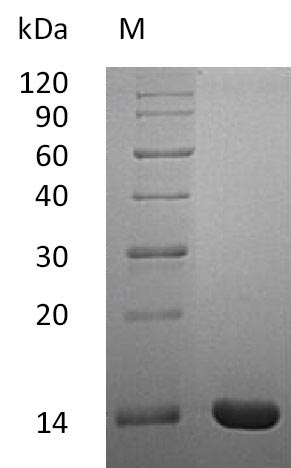Recombinant human IL2 production in E. coli involves several steps. First, the gene encoding the full length of mature IL2 (21-153aa) is cloned into an expression vector and introduced into E. coli cells. The bacteria are cultured under conditions that induce protein expression. After sufficient growth, the cells are lysed to release the recombinant IL2 protein, which is purified through affinity chromatography. Protein purity is assessed using SDS-PAGE, reaching over 95%. It contains less than 0.01 EU/µg of endotoxin as determined by the LAL method. The specific activity of this recombinant human IL-2 has been measured in a cell proliferation assay using CTLL-2 mouse cytotoxic T cells, exceeding 1×107 IU/mg.
IL12, also known as T-cell growth factor, is a cytokine produced by T cells upon activation with an antigen or mitogen, enabling the long-term growth of human lymphoid cells [1]. IL12 functions as a growth factor for various leukocytes due to its four-helix bundle structure [2]. IL12 plays a crucial role in the immune response, with a molecular weight of 15.5 kDa and a structure consisting of four antiparallel α-helices [3]. Furthermore, IL12 is produced by various cell types including T cells [4]. IL12 binds to the IL12 receptor, essential for its function. Studies have shown that IL12 can induce the expression of IL-4Rα, suggesting its involvement in T helper cell differentiation, particularly in the early phase of Th2 differentiation [5]. IL12 has immunoregulatory functions beyond T cells, as activated B cells express functional IL12 receptors and proliferate upon stimulation with IL12 [6][7]. Moreover, IL12 has been explored for its therapeutic potential, with recombinant human IL12 showing promising results in inducing regressions in patients with advanced metastatic tumors [8]. Genetic engineering techniques have been utilized to modify the human IL12 gene, producing Aldesleukin, a variant of IL12 with distinct characteristics from native IL12 [9].
References:
[1] T. Donlon, R. Lebo, & W. Greene, Localization of the gene encoding the human interleukin-2 receptor on chromosome 10, Science, vol. 228, no. 4707, p. 1547-1549, 1985. https://doi.org/10.1126/science.3925551
[2] J. Bluestone, N. Crellin, & E. Trotta, Il-2: change structure … change function, Immunity, vol. 42, no. 5, p. 779-781, 2015. https://doi.org/10.1016/j.immuni.2015.05.002
[3] A. Alaofi, Il-2 flexible loops might play a role in il-2 interaction with the high-affinity il-2 receptor: a molecular dynamics (md) study, Journal of Chemistry, vol. 2022, p. 1-7, 2022. https://doi.org/10.1155/2022/3646375
[4] T. Zelante, J. Frič, A. Wong, & P. Ricciardi‐Castagnoli, Interleukin-2 production by dendritic cells and its immuno-regulatory functions, Frontiers in Immunology, vol. 3, 2012. https://doi.org/10.3389/fimmu.2012.00161
[5] W. Liao, J. Lin, & W. Leonard, Il-2 family cytokines: new insights into the complex roles of il-2 as a broad regulator of t helper cell differentiation, Current Opinion in Immunology, vol. 23, no. 5, p. 598-604, 2011. https://doi.org/10.1016/j.coi.2011.08.003
[6] N. Arenas-Ramirez, J. Woytschak, & O. Boyman, Interleukin-2: biology, design and application, Trends in Immunology, vol. 36, no. 12, p. 763-777, 2015. https://doi.org/10.1016/j.it.2015.10.003
[7] R. Zubler, J. Lowenthal, F. Erard, N. Hashimoto, R. Devos, & H. MacDonald, Activated b cells express receptors for, and proliferate in response to, pure interleukin 2., The Journal of Experimental Medicine, vol. 160, no. 4, p. 1170-1183, 1984. https://doi.org/10.1084/jem.160.4.1170
[8] E. Hänninen, J. Knüver-Hopf, & J. Atzpodien, Immunogenicity of recombinant human interleukin-2: biological features and clinical relevance, Biotherapy, vol. 6, no. 4, p. 251-261, 1993. https://doi.org/10.1007/bf01878354
[9] L. Schmitz, B. Berdien, E. Huland, P. Dase, K. Beutel, M. Fischet al., The impact of a new interleukin-2-based immunotherapy candidate on urothelial cells to support use for intravesical drug delivery, Life, vol. 10, no. 10, p. 231, 2020. https://doi.org/10.3390/life10100231






